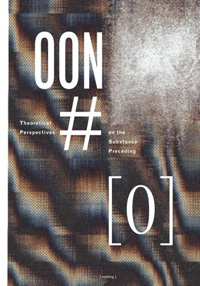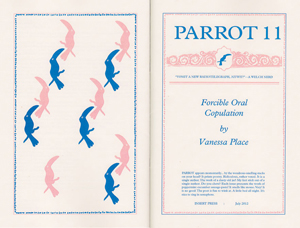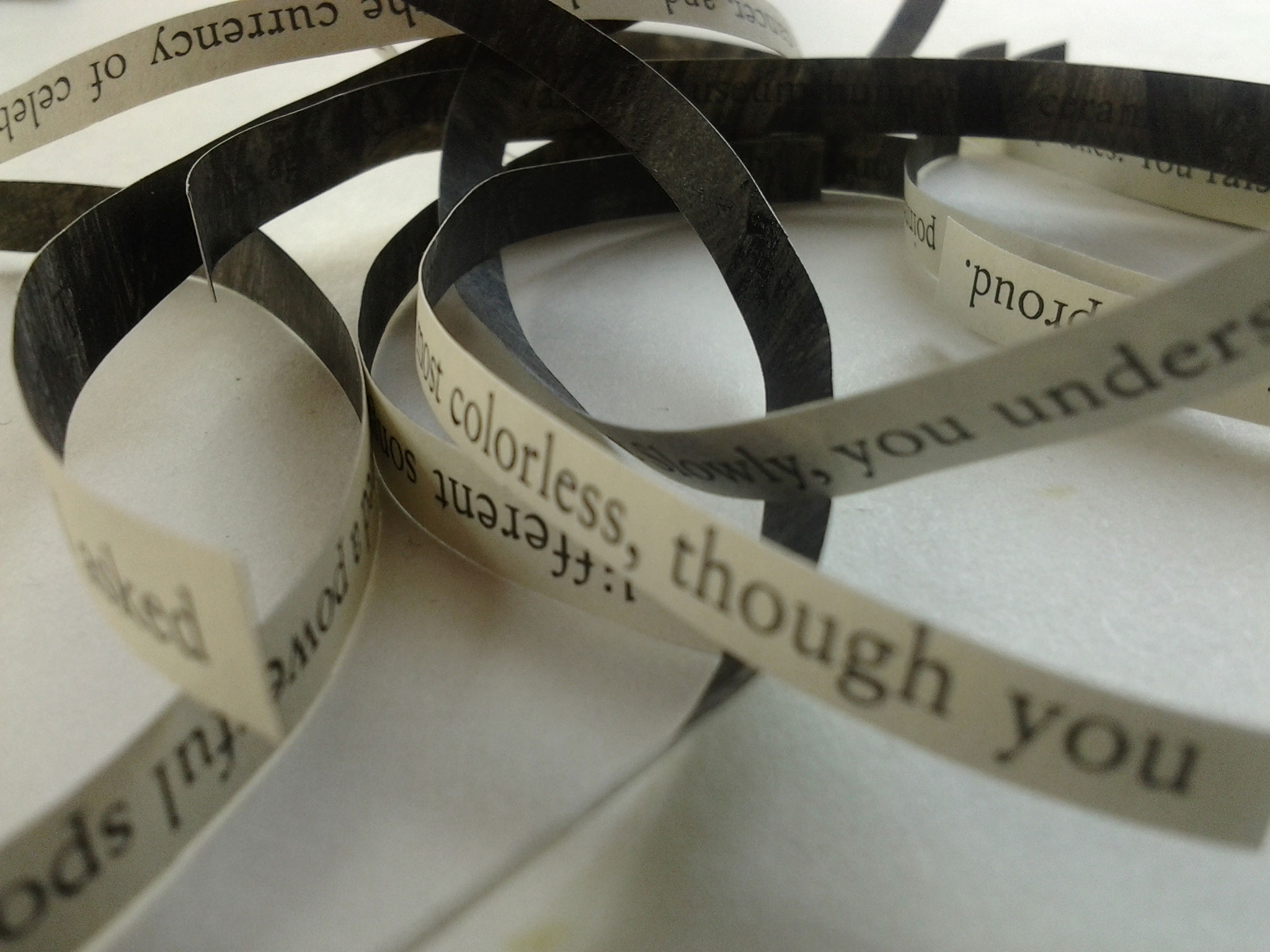GUANTANAMO by Frank Smith, Trans. By Vanessa Place
 GUANTANAMO
GUANTANAMO
by Frank Smith
Translated by Vanessa Place
Les Figues Press, July 2014
160 pages / $17 Buy from Les Figues or SPD
As a law student, I feel that the most important demographic that this book should reach is law students—but for various reasons, it will never reach them.
When reading Guantanamo, I thought back to my Constitutional Law class and our discussions of the constitutional rights of foreign nationals. We learned about the debate through the lens of Guantanamo, specifically Combatant Status Review Tribunals (CSRT), which was challenged on constitutional grounds. As the introduction of this book informs, prisoners in the U.S. are guaranteed habeus corpus relief from unlawful detention. Such relief is generally called for when there is no knowledge of charges by or evidence against the detained person.
The introduction by Mark Sanders talks about translation and how Frank Smith drafted this book in French based on actual interrogation reports. It implies that there is no text under the text, only layers of translation with no correct source document: not only is there the language barrier between the author and the interrogation, but there is also the communication barriers between the Middle Eastern citizens and the U.S. interrogators. Law is very much the same way in having no definitive text. It is a mosaic bible made and revised by humans, primarily rich white American men (even still!) in this country. And yet, those who endeavor to work in it have their very human blind spots, such as the war vet in class who did not want to reconcile with “terrorists” having rights—that the Supreme Court should not pander to terrorists in giving them due process in our courts of law.
The text itself revolves around a trinity of ambiguity, vegetables, and the United States of America. The ambiguity in the writing comes from the use of the French pronoun on to show the absurdity and inhumanity of Guantanamo’s process. You observer a recurring narrative that the reader is unsure of is two continuous characters or two general bodies: (1) “the terrorists”; and (2) “the administrative body conducting de facto trials.” Vanessa Place translates on in a variety of permissible ways depending on tone, or not, or maybe creating her own tone in an unsettling way. Sometimes we are pronounless.
Asks if has family ties with known terrorists in Pakistan.
Answers exactly what kind of ties?
Rephrases the question, asks if any relatives have ties to terrorists in Pakistan.
Answers has no family in Pakistan. How could this be?
States has “kin” who is a member of a terrorist group responsible for attacks in Uzbekistan.
Answers no one in the family has any connection with any terrorist group in Uzbekistan to speak of. (p. 3)
And so on. Not only does this stylistic choice call to attention the human machinery at work here, but it also creates a haunting, disorienting effect. Who are you supposed to believe? There is no human face that you are supposed to recognize here. There are combating facts which simply do not add up. And here, unlike the real U.S. criminal justice system (for all its flaws), there is no plea bargain to a lesser crime, there are no charges. Your reward for confessing to being an enemy combatant is to remain there, indefinitely, perhaps forever, even if really you were just growing vegetables, at the wrong place and at the wrong time.
The whole book goes like this, in deadpan call-and-response, with occasional breaks into a very sparse poetry, absent of any embellishment. It is not quite as dry as the interrogation proceeding, but only not quite.
“The man, his wife, and his mother still believed
they were being taken to Uzbekistan
but when they reached the other side of the river
a Tajik man informed them that they were actually
entering Afghanistan
and that they would have to fend for themselves,
that Tajikistan had effectively decided
to get rid of its Uzbek immigrants
Some families attempted to object
because they did not want to be abandoned there
but they were threatened with death
if they did not stop complaining.
The man believes they were then
in the area of Ahmed Shah Massoud.” (p. 53-4)
The author instead uses this break to tell the straightforward narrative of the de facto defendant(s), in broken up third-person prose, as if these defendants were not allowed to tell their stories directly and that the only voice which spoke for them was the voice of Allah. Their voices are suppressed, and simultaneously horrifying and bland. They are made bland. They are ruled by the farming of vegetables, caring for their families through agrarian life, until they are expulsed then tricked by ill-meaning “friends.” These narratives are frequent and often in this book, and probably in life too. Yet they are rendered “boring” and unaesthetic. I think this is important.
And at the end, nothing happens. Not in this book, or in the thing it is modeled after as conceptual art, until the shifting mind-mass of law went in the direction of abolishing the kangaroo courts, and setting some of the particulars free. The undangerous ones. Hopefully—but how are we supposed to know?
The worst kind of ambiguity, yet depicted flawlessly.
***
Rory Fleming is a rising third year law student at the University of North Carolina-Chapel Hill. He is also a writer of prose and poetry.
June 30th, 2014 / 10:00 am
Announcing Requited #10
I’m pleased to announce that the tenth issue of Requited is now online and contains:
- Fiction by Rich Ives and Lauren Wallach;
- Poetry by Janelle Adsit, Naomi Buck Palagi, Lance Garland, Matt Trease, Lina ramona Vitkauskas, and Caroline Crew & Chris Emslie;
- Nonfiction by Virginia Konchan and Jarrett Neal;
- Visual art by Jenny Magnus, Nicole Matos, and Zoe Nelson.
Furthermore, in the journal’s rapidly-growing archives, you’ll find poetry by Molly Gaudry and Nate Pritts; fiction by James Tadd Adcox, Jimmy Chen, Jac Jemc, Tim Jones-Yelvington, and Suzanne Scanlon; nonfiction by William Bowers, Jeremy M. Davies, Julianne Hill, Steve Katz, Mark Rappaport, Keiler Roberts, Viktor Shklovsky, and Curtis White; interviews with Robert Ashley and Vanessa Place—and other wonderful things.
Enjoy!
Felix Bernstein’s Response to Vanessa Place, Slavoj Žižek, Trisha Low, and more
Beyond Vampires and Zombies
An Essay by Felix Bernstein
Vanessa Place’s latest manifesto “Zombie Poetry”[1] accurately frames her modus operandi: to glorify (and sanitize) Freud’s death drive (in which, doomed to never get what you want, satisfactory pleasure becomes impossible), over and against eros (the principle of maximizing pleasure). She provides a didactic demonstration of the death drive by casting herself in the role of Thanatos, a self-proclaimed undead zombie, feeding off (appropriating) the naïve pleasure of those feebleminded creatures who attempt to maximize pleasure, lecturing us that our notion of satisfaction and of mastery is a lie. Place is largely influenced by the famous schtick of Lacanian philosopher Slavoj Zizek, who is a master of belittling the part of us that believes we will find fulfilling objects. His refrain, like the song, is you can’t get what you want but you can get what you need, with this kicker: what you need is an unpleasant excess in the object of your desire that serves as a reminder/remainder of that which is denied in sexual relationships. This unpleasant excess, so-named “the kernel of the real,” can be found as the remainder of fantasies and mathematical equations To extract this rem(a)inder, you must read between the lines of speech, strictly under the Lacanian rubric. Then you will always find this same truth: the split subject, barred from accessing its full desire; in other words, the truth is the failure of desire. And this truth will always be delivered, for it is universally applicable.
For Place, those ‘poets’ who have not taken the conceptual turn that she prescribes, are in the thrall of a silly fantasy that our words might matter before they are decoded, analyzed, or appropriated by a master-analyst. [2]. This is her charge against those poets who have not sufficiently removed themselves from the craft of voicing desire. But also, more troubling, the voices that Place appropriates (the dumb college jokes, the early feminist dogmas, the victim’s testimony) all are framed as being (in their original utterances) naively unaware of the critical discourse into which she is happy to drag them. Those who take on the ‘voices of others,’ be they infused by the traditions of Language or Flarf or New York School poetics [or romanticism or camp or punk] will for Place indulge in an ideological fantasy that does not properly recognize or critique itself. But we all indulge a bit now and then, don’t we? And so it is only human (in the ‘living breathing’ sense) that now, in “Zombie Poetry” when the prospect of Place herself losing relevance enters the scene, that she can finally ask us to be concerned about the personal, the tragic, and the autobiographical, at the expense of the comic and universal. Now, she begs, we ought to look at her particular case, her particular deadpan style, her “I’m melting” bathos, and feel for her! That is, we ought to feel for the woman who is unfeeling.
Indeed, those who do feel for Place now, those who do still recognize her as a mother to their art, but refuse to follow her dogmatically, even those followers, she ridicules for being stupid enough to ‘pay her’ to fulfill this role. By her own calculations, it is inconsequential whether or not one ‘likes’ Vanessa Place, for ‘liking’ is merely a dumb, naïve, response, suitable for social media. It only matters whether or not one is driven to her. And she will, indeed, find that many will be driven her way. And driven by a death drive that is, unlike the one late Freud describes, vaguely pleasant. That is because it is nothing other than a performance of death drive, in the skilled manner of Place or Zizek, it is intelligible, hip, ironic, and stripped of any great dangers. It is in fact more optimistic, gung-ho, communal, and ego-affirming than those arts that indulge openly in true eros. It does not threaten civilization or even make us better understand its discontents. Rather, such performance of thanatos smoothly valorizes what might otherwise have been disruptive, if it were rendered with aesthetic brilliance instead of uncompromising didactic un-deadness.
The vampiric persona has long been iconic of positive, sympathetic, communal identification with the death drive. This identification goes beyond “Garbo is the best” because it is also ” “Garbo’s coldness is our coldness.” Even when nakedly announced in Freudian terms, the death drive is often used as communally binding tool; for example, Lee Edelman’s No Future: Queer Theory and the Death Drive, a revered book in the literary academy (not to mention in the cults around Freud, Zizek, and Lacan). The art world and the pop world, epitomized by Warhol or Lady Gaga, respectively, has found numerous ways to cash in on such glamorous thanatos; but too often the result is art that has zero stakes in its self-conscious display of determinately empty signifiers. Such vampiric signifying feeds on the flesh of signifiers, styles, and dialects that remains alive for those “others” from whom they are appropriated. The vampire thrives via the necrotizing of living symbols for the purpose of galvanizing cash and social mobility. This is why Claire Bishop can praise ‘dark, critical, negativity’ in art (and find Conceptual Poetry to be perfectly negative), all the while, attempting unabashedly to usher these ‘negative’ new forms of art in to the halls of high commodities, with her critical stamp of approval writ large. Of course, such ‘negativity,’ as Zizek or Place or Gaga or Warhol offers, is only as ‘negative’ as it is completely intelligible to art audiences, and it will be forever intelligible because it has no ambivalence about using the signifier, ruthlessly, to prove its point (which is, after all, nothing more than to show that the empty signifier trumps what is conservatively viewed to be an authentic display of desire). But maybe the simplest example to look to, for now, is Twilight, where young Bella, ambivalent about how to register affect, ends up choosing the learned, urbane, death drive of the vampires over and against the dumb, rural, pleasure principle of the werewolves. Which one would you pick? It must be hard being a young post-feminist!
25 Points on Ideisms: Beginnings Toward the Poetics of Always After

Being a Review of Notes
on Conceptualisms
by Robert Fitterman and Vanessa Place
Notes on Conceptualisms
by Robert Fitterman and Vanessa Place
Ugly Duckling Presse, 2009
80 pages / $10 buy from UDP
As it is high time that our growing faction of Ideists had a manifesto around which they could unite, we, that is, Joel Kopplin and Kurt Milberger, humbly offer these notes toward a report of the history and conceptions of Ideisms with particular emphasis on the practice’s aesthetics, specifically poems.
1) The poetry of Ideism: the hangnail that breeds, that bleeds when finally plucked.
2) Books are bound to remain unread because to really read is a kind of rape.
3) Ideism thinks through houses, beyond their walls and windows, and out into the atmosphere where it burns as falling space junk.
4) Ideism is the eternal window out, the rhombus artfully set before venetian blinds, condensed so as to see the street below to approach the equation: what, finally, is next?
5) The permutations of the phrase reveal the poetics of Ideism. Id-e-ism. I-deism. Id-eism. The symbol multivocates, illuminates, and refuses to condense its referent.
6) Ideist poetry reconstructs new acronyms which compress and describe discourse-specific speak: philistines and neophytes fall down and weep with shame upon the altar of each letter of the new word. READ MORE >
July 2nd, 2013 / 1:08 pm
OUT OF NOTHING #[0]; Or, blurbing the whole cacophony
 [out of nothing] #0: theoretical perspectives on the substance preceding [nothing]
[out of nothing] #0: theoretical perspectives on the substance preceding [nothing]
Ed. [out of nothing], October 2012
144 pages / $12 Buy from Amazon or Createspace
When the opportunity presented itself to review the printed edition of [out of nothing] recently, I jumped on it quicker than anything I’ve jumped on since I was ten. The idea in my mind wasn’t even necessarily to “review” OON but just to be able to hold the thing in my hands, first and foremost. [out of nothing] and Lies/Isle are obsessions of mine of late—the online versions, that is; these strange permutations of art and thought and science and everything intellectually captivating you could imagine organized into endless mazes of online content. If we’re to believe in such a thing as collaborative arts on the internet, this, in my opinion, is the sort of thing heading up the effort.
So anyway, I immediately requested a review copy of [out of nothing] and when it reached my house I felt connected to something likely akin to movements in the art scenes of New York in the 70s and 80s or Berkeley and various Western lands in the 60s. Here was the personification of serious writing and art in the twenty-first century and here was my opportunity to consider it. To be sure, considering it is likely the greatest feat I’ll here be able to accomplish. I’ve tried over the past few months to conceive of items to potentially submit to a publication like OON and I can’t for the life of me make it happen. Perhaps it has something to do with the collaborative nature of the thing, perhaps the three editors and founders of OON are just that-fucking-savvy that they’ve managed to push the intellectual envelope even more, I’m not sure. All I know is, if The New Yorker was once taken (dreadfully) seriously as a hub to receive one’s culture, [out of nothing] (both the print and online version) is its strange twenty-first century cousin doing bizarre rituals/experiments in the city’s basement trying to reanimate the corpse of Soren Kierkegaard.
But I digress:
Considering the structure of this anthology, I’m going to move through and evaluate each piece in order with as calculated a response as I can muster. This being an anthology of the highest order, my efforts as critic of OON will be best if the responding structure of my own writing not attempt the strange collective genius inherent to that which I’m writing about. I featured the subtitle “blurbing the whole cacophony” to draw comparisons with Melissa Broder’s piece “blurbing every story in the new New York Tyrant,” because it’s helpful to have something to riff off of this time of year, when the mind slows down and wants only to recoil into hours of sleep. O sleep.
(Furthermore, given the array of materials that exists within the 144 pages of OON, the length and style of my interpretations will vary, and where my words will surely fail to illustrate the images/texts and their substance, I’ll include scanned images of pages because I’m not beyond that and I love this fucking thing too much to assume to understand it.)
Now, regarding the introduction:
IS THAT ALL THERE IS?
by Jon Wagner
Reading this, I’m reminded of something Rick Roderick says in his lecture regarding the works of thinkers like Foucault, or Habermas—and one could easily expand this to Deleuze, or even Derrida if one was so inclined—whose works can hardly be called “philosophy,” in the traditional sense. He goes on to emphasize that contemporary “thinkers,” must encapsulate more of society than was previously expected of philosophy, and that the greats like Foucault or Nietzsche must be acknowledged as something else to be understood. Not only can Wagner’s introduction not be called an “introduction,” in the strict understanding of the word, but it belongs alongside the works of those aforementioned thinkers as something transcending mere criticism, philosophy, history, geneology, ontology; the list goes on. What’s given here is first a consideration of the idea of [nothing],’ and what the bracketing of the word/idea itself might mean, then an introduction to the proceeding texts is given and it’s briefly explained that commentary will be provided by a handful of “Jabberwocks,” along the way—“Benjamin, Baudrillard, Derrida, and Kierkegaard. This is something I’ve not seen done, like, ever, and in addition to creating this extremely fun intertextual environment while reading, it brings to mind all kinds of questions about the apocryphal, marginalia in general, and ghosts. My own thoughts here channel and mimic Deleuze, Pasolini, and Miss Peggy Lee within a restricted economy of expression that bleeds a general excess in the very effort of constriction.” I.E. OON does not seek to be a mere anthology, nor even a mere physical book, and will go so far as to resurrect the dead in texts to bury its collective mind in the concepts of nothingness as deeply as possible. This is unlike anything dubbing itself an anthology that I’ve yet experienced, and onward we must go.
PRE-WAR
Nicholas Grider
I’ve wondered a great deal lately about the idea of a text somehow avoiding the idea of a start and finish entirely, and bridging the gap towards something more diffuse. One thinks of Joyce in this regard and Finnegan’s Wake, or perhaps something more contemporary like Lost Highway, but even still these things do have a beginning as far as location is concerned (the “first” page, the “opening” of the film). I’d feel safe in positing that Grider’s piece comes close to achieving this rather timeless sensation. Although the writing only runs across three pages, the blend here of Walter Benjamin’s and Jean Baudrillard’s insights with the author’s own do lend an eerie, spectral air to the thing and that tied with the fractured indentation of Grider’s lines tempted me to read the thing out of order, forwards and backwards; as many ways as I could considering its brevity. I won’t begin to argue that we’re a great deal closer to printed texts that could actually be called diffuse in this regard, but this first in the anthology does seem to chip away at this idea. I’ll include here the interplay between Grider and Baudrillard, without question my favorite moment in the piece.
“or you have better things to do, you are a background character who laughs a little too long at the funeral parlor with 2.5 walls, you can do a lot of things with flashcuts these days, jackknifing, binge drinking, shoplifting, heavy breathing. {}
{Indeed, you can, when the reified even it so much so that a single marker can indicate an
entire conceptual package: an action, a life, an historical trajectory. JB}”
READ MORE >
May 8th, 2013 / 11:00 am
Another way to generate text #7: Gysin & Burroughs vs. Tristan Tzara
A while back, I ran a little series, “Another way to generate text.” The first one proved fairly popular, and I’ve been meaning to make more of them, but generative techniques haven’t been on my mind. However, my post last week, “Experimental fiction as principle and as genre,” generated a lot of text (haha), in the form of comments. Some people who chimed in questioned whether the Cut-Up Technique that Brion Gysin and William S. Burroughs developed and used in the 1950s was ever all that experimental. Specifically, PedestrianX wrote:
I find it hard to accept this argument when its main example, the Cut-up, didn’t start when you’re claiming it did. I’m sure you know Tzara was doing it in the 20s, and Burroughs himself has pointed to predecessors like “The Waste Land.” Eliot may not have been literally cutting and pasting, but Tzara was.
This comment got me thinking about the role influence plays in experimentation; more about that next week. Today I want to address the point PedestrianX is making, as it strikes me as pretty interesting. Were Gysin and Burroughs merely repeating Tzara? Or were they doing something substantially different?
To figure that out, I decided to run through the respective techniques, documenting what happened along the way. Because if I’ve learned anything in my studies of experimental art, it’s that thinking about the techniques is usually no substitute for sitting down and getting one’s hands dirty.
If you want to get dirty, too, then kindly join me after the jump . . .
Experimental fiction as genre and as principle
A few years ago at Big Other I wrote a post entitled “Experimental Art as Genre and as Principle.” That distinction has been on my mind as of late, so I thought I’d revisit the argument. My basic argument then and now was that I see two different ways in which experimental art is commonly defined.
By principle I mean that the artist is committed to making art that’s different from what other artists are making—so much so that others often don’t even believe that it is art. As contemporary examples I’m fond of citing Tao Lin and Kenneth Goldsmith because I still hear people complaining that those two men aren’t real artists—that they’re somehow pulling a fast one on all their fans. (Someday I’ll explore this idea. How exactly does one perform a con via art? Perhaps it really is possible. Until then, I’ll propose that one indication of experimental art is that others disregard it as a hoax.) Tao visited my school one month ago, and after his presentation some folks there expressed concern, their brows deeply furrowed, that he was a Legitimate Artist—so this does still happen. (For evidence of Goldsmith’s supposed fakery, keep reading.)
Eventually, I bet, the doubts regarding Lin and Goldsmith will fall by the wayside. Things change. And it’s precisely because things change that the principle of experimentation must keep moving. The avant-garde, if there is one, must stay avant.
That’s only one way of looking at it, however. Experimental art becomes genre when particular experimental techniques become canonical and widely disseminated and practiced. The experimental filmmaker Stan Brakhage, during the 1960s, affixed blades of grass and moth wings to film emulsion, and scratched the emulsion, and painted on it, then printed and projected the results. Here is one example and here is another example. And here is a third; his films are beautiful and I love them. (The image atop left hails from Mothlight.) Today, countless film students also love Brakhage’s work, and use the methods he popularized to make projects that they send off to experimental film festivals. (Or at least they did this during the 90s, when I attended such festivals; I may be out of touch.)
Those films, I’d argue, while potentially beautiful and interesting, are not necessarily experimental films. As far as the principle of experimentation goes, those students had might as well be imitating Hitchcock.
Announcing Requited Journal #8
It is my pleasure to tell you that Requited #8 is now online. This issue features:
- Fiction by Thomas Mundt, Berit Ellingsen, and Matt Rowan;
- Poetry by Lucy Biederman, Carol Guess & Kristina Marie Darling, Gillian Cummings, Zachary Scott Hamilton, Kamden Hilliard, Kati Mertz, M. Pfaff, Amanda Silbernagel, and Michelle Sinsky;
- Performance pieces by Marisa Plumb, Dave Snyder, and Brian Torrey Scott;
- Visual art by Tyler Mallory (including the image you see above);
- Jeff Bursey’s review of Sam Savage’s Glass.
Check it out!
. . .
I am the non-fiction and reviews editor for Requited and am always eager to consider submissions. Previously I’ve published work by William Bowers, Jeremy M. Davies, Julianne Hill, Steve Katz, Mark Rappaport, Keiler Roberts, Viktor Shklovsky, and Curtis White, as well as interviews with Robert Ashley, Vanessa Place, Rosmarie Waldrop, and Curtis White, and reviews by Daniel Green and Jeff Bursey.
Also, please do check out the Requited‘s steadily swelling archives, where you’ll find poetry by Molly Gaudry and Nate Pritts, fiction by James Tadd Adcox, Jimmy Chen, Jac Jemc, Tim Jones-Yelvington, Suzanne Scanlon, and (ahem) myself, as well as many other nice fine things.
Enjoy!
How to Review Vanessa Place’s Forcible Oral Copulation
 Parrot 11: Forcible Oral Copulation
Parrot 11: Forcible Oral Copulation
by Vanessa Place
Insert Blanc Press (Parrot Series), 2012
18 pages / $9.00 Buy from Insert Blanc Press
1. You could just write a short summary of the chapbook, which is artfully arranged and darkly comic legal testimony of, no surprise, forcible oral copulation. You could mention that it’s part of Insert Blanc’s Parrot series, provide an excerpt like the one below, and write something to the effect of writing a review of Strict-Lift Conceptual Writing is sort of like writing a review of a rock: is it a good rock? Does it fulfill its implicit goals of being a rock? And so on.
When asked if he orally copulated his victims, appellant said he hadn’t; when asked if he’d forced his victims to orally copulate him, appellant said he hadn’t; later, appellant said maybe he had.
2. You could breeze through description and head straight into a discussion of Strict-Lift Conceptual Writing (henceforth SLCW), outlining the history and current state of it and then providing your opinion of it, writing maybe that unlike the more engaged conceptual writing found in great books like I’ll Drown My Book SLCW is sort of like the kind of joke that’s only funny the first time. The novelty wears off yet you keep hearing the same joke and you’re too bored to laugh so the joke-teller tries to confront you with titillating and/or shocking subject matter and you yawn because SLCW is SLCW is SLCW.
3. You could breeze through points numbers one and two and throw down a gauntlet maybe something like Forcible Oral Copulation would be right at home on Paul Ryan’s bookshelf next to his Rush Limbaugh books because SLCW is inherently neoconservative in its negation of creativity, complexity, and pleasure in favor of dumb objects. SLCW the opposite of Conceptual Art’s dematerialization, a fetishizing of the material and content-free vs. anything remotely avant or provocative, and you could maybe say that SLCW is not going to hurt you but it’s sort of like trying to swat a dead fly with a completely numb arm. You’d go on to shore up your dragging in of capital P Politics by paraphrasing Adrian Piper’s statement that all art is political, whether explicitly or implicitly, and you’d compare the production of SLCW unlike thrilling freeform conceptual writing as a shutting down of possibility, a reduction, conservatism in the literal sense and so in the political. Or maybe you’d avoid politics because SLCW is maybe the it-girl of the 21st century alt lit scene and knocking it would be like yelling back at the television in a room full of people who want you to shut up and just watch like a reasonable person or else leave quietly.
4. You could talk about your history as a rape survivor and wrap your discussion of Forcible Oral Copulation around its ability to do anything other than function as the outcome of an idea, simple curation that puts you on edge even though you’re supposed to be clinically distant and Over It anyway.
5. You could zoom through points one through three and go light on the politics in favor of discussing why conceptual writing, along with The New Sincerity, are relics of Bush-era willful ignorance because both SLCW and The New Sincerity are not sincere but naive in their fumbling mimicry of something past or lost and serve the purpose to present a literary angle of attack that reduces literature to something fundamentally unchallenging and unnecessary. You could maybe bring politics in at this point but maybe not.
December 17th, 2012 / 12:05 pm
Q.E.D. – Part 3: An evening of Authentic Objects
The MAK Center Schindler House, Los Angeles
13 June 2012
Context Note: In April, May, and June of this year, Les Figues Press hosted a short series of long conversations on queer art and literature. Titled Q.E.D., in honor of Gertrude Stein’s novel by the same name (and one of the earliest coming-out stories), each Q.E.D. event explored the constructions of speech, art, literature, materiality, and sex. The conversations were moderated by Vanessa Place at the historic MAK-Schindler House, L.A.’s original nod to green architecture.
Q.E.D. Part Three featured Dodie Bellamy, Julie Bamber, and Terry Castle.
***

An evening of Authentic Objects: Julie Bamber, Dodie Bellamy and Terry Castle in conversation.
In the third installment of Les Figues Press’ Q.E.D. Series, moderated by Vanessa Place, the initial questions were, “Does an object need a form? Does an objection? Does anything speak for itself?” Artist Julie Bamber, writer Dodie Bellamy and critic (and writer and artist) Terry Castle assembled in the MAK Schindler House in West Hollywood to discuss questions of object-hood before an excited audience.
Patrons gathered, drank Pellegrino and looked at programs. Grapes and cookies sat on a table on the lawn. The copper of the fireplace was bright, next to the concrete walls of the house, with low beams suspended with small lights. A sliding door opened the wall. Afternoon light slanted across the concrete floor, grey.
July 6th, 2012 / 12:00 pm





